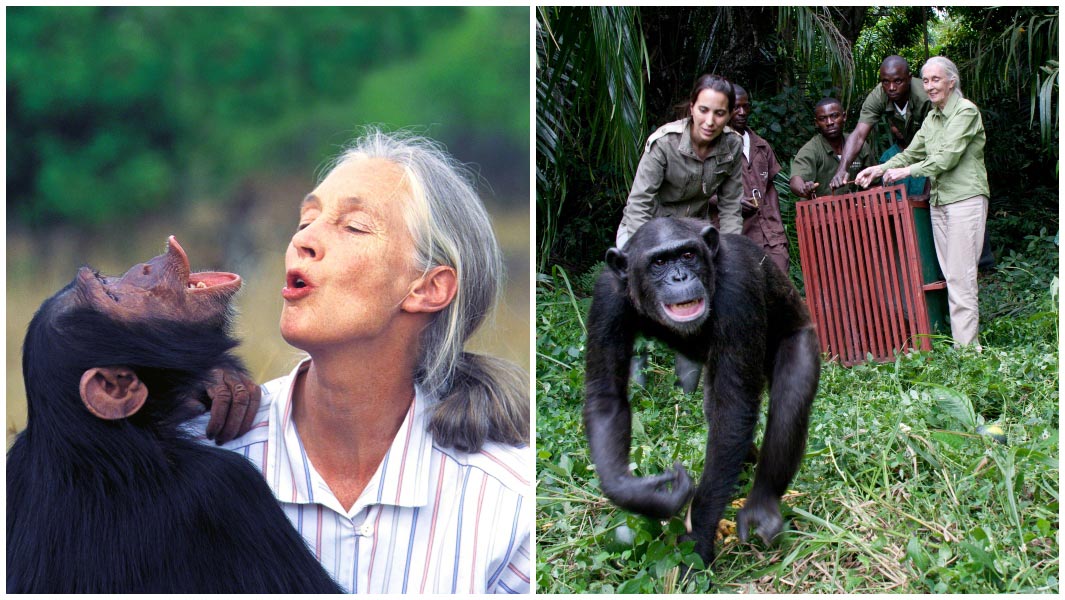Jane Goodall’s pioneering chimp research recognized with GWR titles

Dr Jane Goodall (UK) knew from a young age that wildlife would be a big part of her life.
Doctor Dolittle , The Jungle Book and Tarzan were all well-thumbed books in her home as a child and, by 10 years old, she had set her mind on travelling to Africa to live with wild animals and to tell stories on them of her own.
Sixteen years later, her childhood ambition became a reality when she intrepidly voyaged to what was then Gombe Stream Chimpanzee Reserve in Tanzania to study its resident primates. A lot has changed since then – both at Gombe, which is now a national park, and beyond with the ever-growing scope of the Jane Goodall Institute (JGI), which was established in 1977.
But while names may have changed and operations scaled up, the fundamental field research at Gombe and the conservation work it extends into goes on to this day. This makes what Goodall began the Longest-running wild primate study on the planet: 58 years and counting.
When Dr Goodall, aged 26, arrived at Gombe with her mother – who travelled with her because the British government would not let Jane travel unchaperoned – in 1960, she was not to find a luxury "eco-lodge" awaiting her in the jungle.
"We had an ex-army tent to share. It didn’t have a sewn-in groundsheet. Snakes, scorpions and all manner of creature could enter – and did! We had two little camp beds," she recalled.
"Our 'bath' was a small canvas affair about 5 x 5 ft [1.5m2] and 3 in [7.6 cm] tall which Dominic, our cook, filled with a little hot water, heated over the wood fire. He also used this fire on which to cook in a 'kitchen' that was open-sided with a palm thatched roof."

It took several months to earn the chimps' trust. Then, one day, Dr Goodall made a breakthrough – all thanks to a little serendipity.
After "miscalculating distances" while navigating the dense rainforest vegetation, she emerged much closer than intended to a group that was grooming. To her surprise, rather than running away, they "looked up and just carried on". She describes this turning point of being accepted into the troop as the "proudest moment of my life".
Over the coming years, Dr Goodall would witness behaviour never before seen, forcing us to rethink our entire understanding not just of chimps, but of primates and of animals altogether.
Not least among her discoveries was a chimp that she had christened "David Greybeard" fashioning a termite-catching device from a twig that he’d stripped of leaves. It was the first time in history that an animal, other than humans, had been recorded using tools.

Nearly six decades on, with more than 165,000 hours of observational data having been collected, Gombe is still bearing witness to milestones.
For instance, Guinness World Records has now confirmed Golden and Glitter – two of the chimps that live in the park – as the Oldest chimpanzee twins . With twins being such a rare occurrence among wild chimps, JGI researchers have been gifted an invaluable opportunity to closely follow the development of these sisters who have now become mothers themselves, one of them to twins herself even!

The work of the JGI now extends far beyond Gombe, with many other conservation projects around Africa, as well as elsewhere across the globe.
As Dr Goodall told us, the charity's remit is now just as much about helping the human communities that live in close proximity to chimps as it is the animals themselves: "We still continue research on the Gombe chimpanzees, but we have also developed programmes to help the local people.
"These are holistic programmes that include suitable farming operations that do not destroy the soil, restoring fertility to overused farmland, shade-grown coffee, better health facilities and better educational facilities working with local Tanzanian authorities.
“We have now developed similar programmes in other African countries around chimp habitats – Uganda, Burundi, DRC, Republic of Congo and Senegal. And we’re starting one in Mali and hoping to do the same in Cameroon and Gabon.”

One initiative that Dr Goodall is particularly proud of is the Jane Goodall Institute’s Roots & Shoots (R&S) programme.
Roots & Shoots focuses on causes that matter most to young people – "for children in kindergarten, students in university and all in between".
These causes are related to wildlife conservation, as well as environmental and social issues. As she points out: "It's hard work to secure funding for operating Institute’s conservation programmes – and what is the use if new generations are no better stewards than we have been?"

Header and thumbnail picture credits: Jane Goodall Institute/Michael Neugebauer
A note from JGI: "Dr Jane Goodall and the Jane Goodall Institute do not endorse handling or interfering with wild chimpanzees. Many of the chimpanzees appearing with humans in images here were rescued and reside in sanctuaries where they are cared for by professionals."
You can read more about Dr Jane Goodall’s incredible research and tireless conservation work in an exclusive interview in Guinness World Records: Wild Things , out now. To learn more about the Jane Goodall Institute and Roots & Shoots programme, visit janegoodall.org and rootsandshoots.org.



